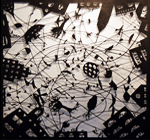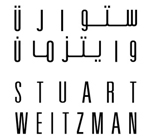
stories in paper-cut silhouettes
Beatrice Coron only started her artist career at the age of 40. Born and raised in Lyon, France, Beatrice worked a variety of jobs and lived in Egypt, Taiwan and ...
More
images . Dumas Mahar . / text . Pauline Chan .
Vivid colours, sharp angles, straight edges - no make-up artist in her right mind will give you those on a date night. However, when cleverly applied to a face for the sake of art, they transform the subject into a visually stunning personality. WPAP, short for Wedha’s Pop Art Portrait is an art style using vector art principles which involves tracing on a photograph of a portrait. WPAP uses only straight lines and solid colours without any gradation. Hence it is typical to see the colours in WPAP art collide shockingly. The tracing rules are not rigid and with the artist’s personal intepretation, this form produces a fresh new feel with every attempt.
WPAP was founded by one of Indonesia’s foremost illustrator, Wedha Abdul Rashid, who is affectionately known as ‘The Father of Indonesian Illustration.’ Born in March 1951, Wedha is famed for the creation of 2 iconic characters – Lupus, a fictional character based on a novel written by Hilman Hariwijaya and Ninol, a cartoon character he created for HAI Magazine. He created the WPAP art style in 1991, back then it was known as Foto Marak Berkotak (Boxed Bloom Photo).

To create the WPAP style, you will need Adobe Illustrator and Adobe Photoshop, but it is also achievable with CorelDraw, Adobe Flash or Microsoft Word. An ardent follower of this style, Dumas Mahar, told us that the hardest parts to get right are the eyes, nose and mouth. In his opinion, these are the key features of any face, if one gets them wrong, the character and familiarity of the subject will be lost. The art and complexity is in creating a cubism feel with distortion but at the same time keeping the subject recognisable. 

WPAP has a big following in Romania and Germany. Interest in the style has grown around the world and new fans are learning the art through e-mails and websites. According to Dumas, there has been some enquiries from artists from Iran, France and India. Back in its founding nation, WPAP art is prominently featured in public events such as the Java Jazz Festival in Jakarta where the WPAP community presents portraits of their favourite jazz artistes in a fireworks of explosive colours.



Bruneians are catching on to this form of pop art, although not on a wildfire-scale, as it is a new and addictive creative outlet - apparently, according to Dumas, once you sit in front of the computer, it is very hard to leave. It is not widely appreciated yet but proponents of this art form like Dumas, are hoping to reach a greater audience and promote the commercial value of this art form with future art exhibitions, workshops and the viral potential of online social network.

stories in paper-cut silhouettes
Beatrice Coron only started her artist career at the age of 40. Born and raised in Lyon, France, Beatrice worked a variety of jobs and lived in Egypt, Taiwan and ...
More

logo arabization : the relevance to brunei darussalam
Jawi is used in billboards, directional and company signages in Brunei Darussalam, so when it comes to localization of international brands, there is usually a level ...
More

a spec check ... before a wreck by neil tortorella
As a creative, odds are at some point in your career you’ll be asked to do a speculative (or spec) project. It comes with the territory. Often these are geared toward ...
More